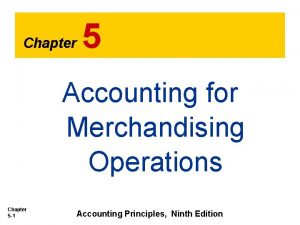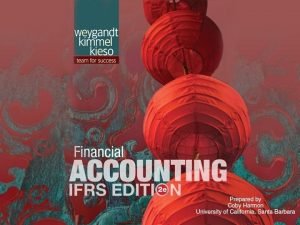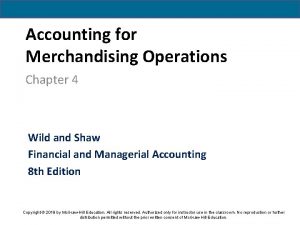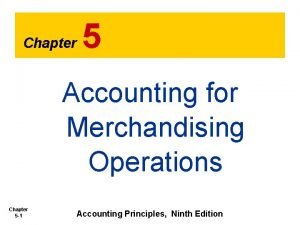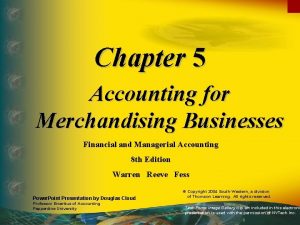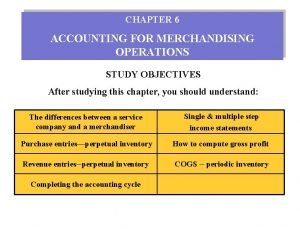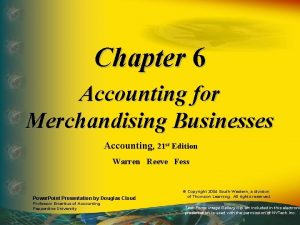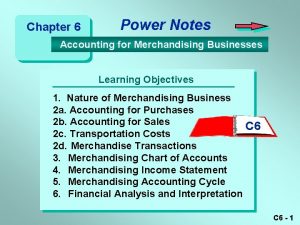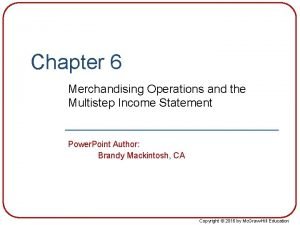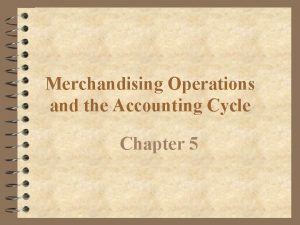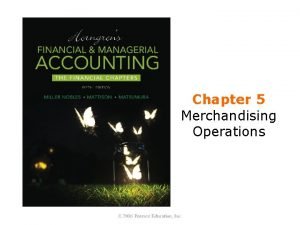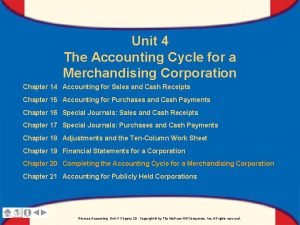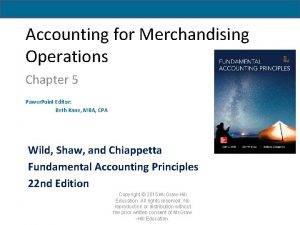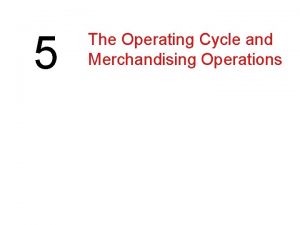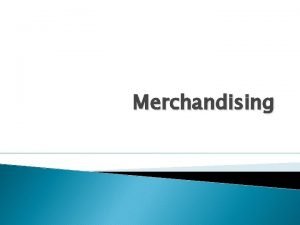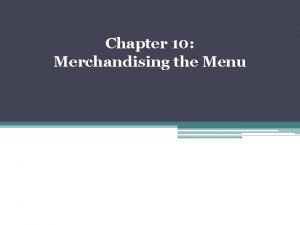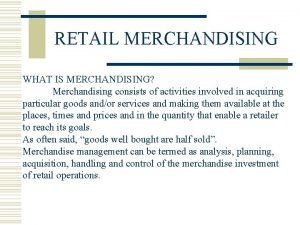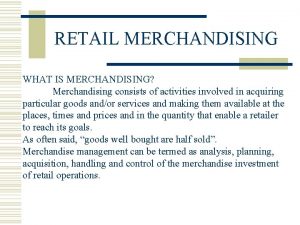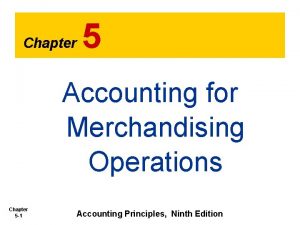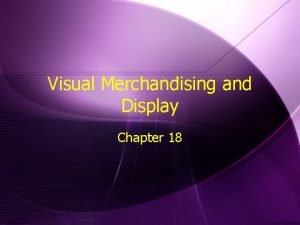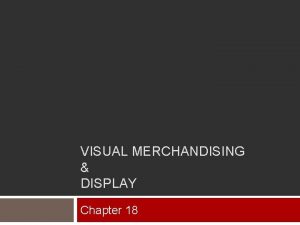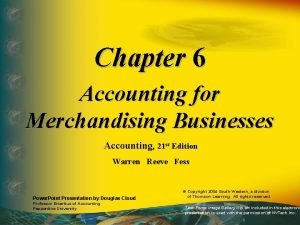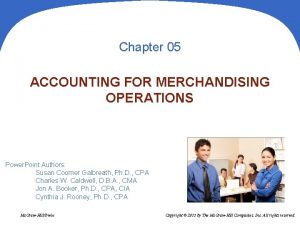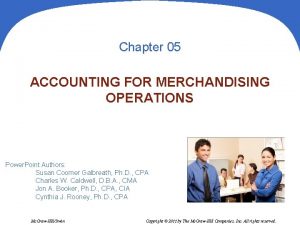CHAPTER 5 ACCOUNTING FOR MERCHANDISING OPERATIONS Chapter 5













































- Slides: 45

CHAPTER 5 ACCOUNTING FOR MERCHANDISING OPERATIONS Chapter 5 -1

Merchandising Operations Merchandising Companies Buy and Sell Goods Wholesaler Retailer Consumer The primary source of revenues is referred to as sales revenue or sales. Chapter 5 -2 LO 1 Identify the differences between service and merchandising companies.

Merchandising Operations Income Measurement Sales Revenue Less Cost of Goods Sold Not used in a Service business. Equals Gross Profit Cost of goods sold is the total cost of merchandise sold during the period. Chapter 5 -3 Illustration 5 -1 Less Operating Expenses Equals Net Income (Loss) LO 1 Identify the differences between service and merchandising companies.

Operating Cycles Illustration 5 -2 The operating cycle of a merchandising company ordinarily is longer than that of a service company. Chapter 5 -4 LO 1 Identify the differences between service and merchandising companies.

Inventory Systems Perpetual System Features: 1. Purchases increase Merchandise Inventory. 2. Freight costs, Purchase Returns and Allowances and Purchase Discounts are included in Merchandise Inventory. 3. Cost of goods sold is increased and Merchandise Inventory is decreased for each sale. 4. Physical count done to verify Inventory balance. The perpetual inventory system provides a continuous record of Inventory and Cost of Goods Sold. Chapter 5 -5 LO 1 Identify the differences between service and merchandising companies.

Inventory Systems Periodic System Features: 1. Purchases of merchandise increase Purchases. 2. Ending Inventory determined by physical count. 3. Calculation of Cost of Goods Sold: Beginning inventory Add: Purchases, net Goods available for sale Less: Ending inventory Cost of goods sold Chapter 5 -6 $ 100, 000 800, 000 900, 000 125, 000 $ 775, 000 LO 1 Identify the differences between service and merchandising companies.

Recording Purchases of Merchandise Made using cash or credit (on account). Illustration 5 -4 Normally recorded when goods are received. Purchase invoice should support each credit Chapter 5 -7 purchase. LO 2 Explain the recording of purchases under a perpetual inventory system.

Recording Purchases of Merchandise E 5 -2 Information related to Steffens Co. is presented below. Prepare the journal entry to record the transaction under a perpetual inventory system. 1. On April 5, purchased merchandise from Bryant Company for $25, 000 terms 2/10, net/30, FOB shipping point. April 5 Chapter 5 -8 Merchandise inventory Accounts payable 25, 000 LO 2 Explain the recording of purchases under a perpetual inventory system.

Recording Purchases of Merchandise Not all purchases increase Merchandise Inventory. E 5 -2 Prepare the journal entry to record the transaction under a perpetual inventory system. 3. On April 7, purchased equipment on account for $26, 000. April 7 Chapter 5 -9 Equipment Accounts payable 26, 000 LO 2 Explain the recording of purchases under a perpetual inventory system.

Recording Purchases of Merchandise Freight Costs Terms FOB shipping point - seller places goods Free On Board the carrier, and buyer pays freight costs. FOB destination - seller places the goods Free On Board to the buyer’s place of business, and seller pays freight costs. Freight costs incurred by the seller on outgoing merchandise are an operating expense to the seller (Freight-out or Delivery Expense). Chapter 5 -10 LO 2 Explain the recording of purchases under a perpetual inventory system.

Recording Purchases of Merchandise E 5 -2 Continued Prepare the journal entry to record the transaction under a perpetual inventory system. 2. On April 6, paid freight costs of $900 on merchandise purchased from Bryant. April 6 Chapter 5 -11 Merchandise inventory Cash 900 LO 2 Explain the recording of purchases under a perpetual inventory system.

Recording Purchases of Merchandise Purchase Returns and Allowances Purchaser may be dissatisfied because goods damaged or defective, of inferior quality, or do not meet specifications. Purchase Return Purchase Allowance Return goods for credit if the sale was made on credit, or for a cash refund if the purchase was for cash. May choose to keep the merchandise if the seller will grant an allowance (deduction) from the purchase price. Chapter 5 -12 LO 2 Explain the recording of purchases under a perpetual inventory system.

Recording Purchases of Merchandise Review Question In a perpetual inventory system, a return of defective merchandise by a purchaser is recorded by crediting: a. Purchases b. Purchase Returns c. Purchase Allowance d. Merchandise Inventory Chapter 5 -13 LO 2 Explain the recording of purchases under a perpetual inventory system.

Recording Purchases of Merchandise E 5 -2 Continued Prepare the journal entry to record the transaction under a perpetual inventory system. 4. On April 8, returned damaged merchandise to Bryant Company and was granted a $4, 000 credit for returned merchandise. April 8 Chapter 5 -14 Accounts payable 4, 000 Merchandise inventory 4, 000 LO 2 Explain the recording of purchases under a perpetual inventory system.

Recording Purchases of Merchandise Purchase Discounts Credit terms may permit buyer to claim a cash discount for prompt payment. Advantages: Purchaser saves money. Seller shortens the operating cycle. Example: Credit terms of 2/10, n/30, is read “two-ten, net thirty. ” 2% cash discount if payment is made within 10 days. Chapter 5 -15 LO 2 Explain the recording of purchases under a perpetual inventory system.

Recording Purchases of Merchandise Purchase Discounts Terms 2/10, n/30 1/10 EOM 2% discount if paid within 10 days. 1% discount if paid within first 10 days of next month. Chapter 5 -16 N/30, m/60, or n/10 EOM Net amount due in 30 days, 60 days, or within the first 10 days of the next month. LO 2 Explain the recording of purchases under a perpetual inventory system.

Recording Purchases of Merchandise E 5 -2 Continued Prepare the journal entry to record the transaction under a perpetual inventory system. 5. On April 15, paid the amount due to Bryant Company in full. (Discount = $25, 000 x 2% = $500) April 15 Accounts payable 25, 000 Merchandise inventory Cash Chapter 5 -17 500 24, 500 LO 2 Explain the recording of purchases under a perpetual inventory system.

Recording Purchases of Merchandise E 5 -2 Continued Prepare the journal entry to record the transaction under a perpetual inventory system. 5. On April 15, paid the amount due to Bryant Company in full. What entry would be made if the company failed to pay within 10 days? April 16 or later Chapter 5 -18 Accounts payable Cash 25, 000 LO 2 Explain the recording of purchases under a perpetual inventory system.

Recording Purchases of Merchandise Summary of Purchasing Transactions E 5 -2 5 th - Purchase 6 th – Freight-in Balance Chapter 5 -19 $25, 000 900 $4, 000 500 8 th - Return 15 th - Discount $21, 400 LO 2 Explain the recording of purchases under a perpetual inventory system.

Recording Sales of Merchandise Made for cash or credit (on account). Illustration 5 -4 Normally recorded when earned, usually when goods transfer from seller to buyer. Sales invoice should support each credit Chapter 5 -20 sale. LO 3 Explain the recording of sales revenues under a perpetual inventory system.

Recording Sales of Merchandise Two Journal Entries to Record a Sale #1 #2 Chapter 5 -21 Cash or Accounts receivable Sales XXX Cost of goods sold Merchandise inventory XXX XXX Selling Price Cost LO 3 Explain the recording of sales revenues under a perpetual inventory system.

Recording Sales of Merchandise E 5 -5 Presented are transactions related to Wheeler Company. 1. On December 3, Wheeler Company sold $500, 000 of merchandise to Hashmi Co. , terms 2/10, n/30, FOB shipping point. The cost of the merchandise sold was $350, 000. 2. On December 8, Hashmi Co. was granted an allowance of $27, 000 for merchandise purchased on December 3. 3. On December 13, Wheeler Company received the balance due from Hashmi Co. Instructions: Prepare the journal entries to record these transactions on the books of Wheeler Company using a perpetual inventory system. Chapter 5 -22 LO 3 Explain the recording of sales revenues under a perpetual inventory system.

Recording Sales of Merchandise E 5 -5 Prepare the journal entries for Wheeler Company. 1. On December 3, Wheeler Company sold $500, 000 of merchandise to Hashmi Co. , terms 2/10, n/30, FOB shipping point. Cost of merchandise sold was $350, 000. Dec. 3 Accounts receivable Sales 500, 000 Cost of goods sold 350, 000 Merchandise inventory 350, 000 Chapter 5 -23 LO 3 Explain the recording of sales revenues under a perpetual inventory system.

Recording Sales of Merchandise Sales Returns and Allowances “Flipside” of purchase returns and allowances. Contra-revenue account (debit). Sales not reduced (debited) because: Ø would obscure importance of sales returns and allowances as a percentage of sales. Ø could distort comparisons between total sales in different accounting periods. Chapter 5 -24 LO 3 Explain the recording of sales revenues under a perpetual inventory system.

Recording Sales of Merchandise E 5 -5 Prepare the journal entries for Wheeler Company. 2. On December 8, Hashmi Co. was granted an allowance of $27, 000 for merchandise purchased on December 3. Dec. 8 Chapter 5 -25 Sales returns and allowances Accounts receivable 27, 000 LO 3 Explain the recording of sales revenues under a perpetual inventory system.

Recording Sales of Merchandise E 5 -5 Prepare the journal entries for Wheeler Company. 2. Variation On Dec. 8, Hashmi Co. returned merchandise for credit of $27, 000. The original cost of the merchandise to Wheeler was $19, 800. Dec. 8 Chapter 5 -26 Sales returns and allowances Accounts receivable 27, 000 Merchandise inventory Cost of goods sold 19, 800 LO 3 Explain the recording of sales revenues under a perpetual inventory system.

Recording Sales of Merchandise Review Question The cost of goods sold is determined and recorded each time a sale occurs in: a. periodic inventory system only. b. a perpetual inventory system only. c. both a periodic and perpetual inventory system. d. neither a periodic nor perpetual inventory system. Chapter 5 -27 LO 3 Explain the recording of sales revenues under a perpetual inventory system.

Recording Sales of Merchandise Sales Discount Offered to customers to promote prompt payment. “Flipside” of purchase discount. Contra-revenue account (debit). Chapter 5 -28 LO 3 Explain the recording of sales revenues under a perpetual inventory system.

Recording Sales of Merchandise E 5 -5 Prepare the journal entries for Wheeler Company. 3. On December 13, Wheeler Company received the balance due from Hashmi Co. Dec. 13 Cash 463, 540 * Sales discounts Accounts receivable * 9, 460 ** 473, 000 *** ($473, 000 – $9, 460) ** [($500, 000 – $27, 000) X 2%] *** ($500, 000 – $27, 000) Chapter 5 -29 LO 3 Explain the recording of sales revenues under a perpetual inventory system.

Recording Sales of Merchandise E 5 -5 Variation Prepare the sales revenue section of the income statement for Wheeler Company. Chapter 5 -30 LO 3 Explain the recording of sales revenues under a perpetual inventory system.

Recording Sales of Merchandise Discussion Question Q 5 -9 Joan Roland believes revenues from credit sales may be earned before they are collected in cash. Do you agree? Explain. See notes page for discussion Chapter 5 -31 LO 3 Explain the recording of sales revenues under a perpetual inventory system.

Completing the Accounting Cycle Adjusting Entries Generally the same as a service company. One additional adjustment to make the records agree with the actual inventory on hand. Involves adjusting Merchandise Inventory and Cost of Goods Sold. Chapter 5 -32 LO 4 Explain the steps in the accounting cycle for a merchandising company.

Completing the Accounting Cycle Closing Entries Close all accounts that affect net income. E 5 -8 Presented is information related to Rogers Co. for the month of January 2008. Required: (a) Prepare the necessary adjusting entry for inventory. (b) Prepare the necessary closing entries. Chapter 5 -33 LO 4 Explain the steps in the accounting cycle for a merchandising company.

Completing the Accounting Cycle E 5 -8 (a) Prepare the necessary adjusting entry for inventory. Cost of goods sold Merchandise inventory Chapter 5 -34 600 LO 4 Explain the steps in the accounting cycle for a merchandising company.

Completing the Accounting Cycle E 5 -8 (b) Prepare the necessary closing entries. Sales Income summary Cost of goods sold Freight-out Insurance expense Rent expense Salary expense Sales discounts Sales returns Income summary Rogers, Capital Chapter 5 -35 350, 000 341, 600 8, 400 350, 000 218, 600 7, 000 12, 000 20, 000 61, 000 10, 000 13, 000 8, 400 LO 4 Explain the steps in the accounting cycle for a merchandising company.

Forms of Financial Statements Multiple-Step Income Statement Shows several steps in determining net income. Two steps relate to principal operating activities. Distinguishes between operating and nonoperating activities. Chapter 5 -36 LO 5 Distinguish between a multiple-step and a single-step income statement.

Forms of Financial Statements Illustration 5 -11 Key Items: Net sales Gross profit rate Chapter 5 -37 LO 5 Distinguish between a multiple-step and a single-step income statement. LO 6 Explain the computation and importance of gross profit.

Forms of Financial Statements Illustration 5 -11 Key Items: Net sales Gross profit rate Operating expenses Chapter 5 -38 LO 5 Distinguish between a multiple-step and a single-step income statement.

Forms of Financial Statements Illustration 5 -11 Key Items: Net sales Gross profit rate Operating expenses Nonoperating activities Net income Chapter 5 -39 LO 5 Distinguish between a multiple-step and a single-step income statement.

Forms of Financial Statements Review Question The multiple-step income statement for a merchandiser shows each of the following features except: a. gross profit. b. cost of goods sold. c. a sales revenue section. d. investing activities section. Chapter 5 -40 LO 5 Distinguish between a multiple-step and a single-step income statement.

Forms of Financial Statements Single-Step Income Statement Subtract total expenses from total revenues Two reasons for using the single-step format: 1) Company does not realize any type of profit until total revenues exceed total expenses. 2) Format is simpler and easier to read. Chapter 5 -41 LO 5 Distinguish between a multiple-step and a single-step income statement.

Forms of Financial Statements Single. Step Chapter 5 -42 Illustration 5 -12 LO 5 Distinguish between a multiple-step and a single-step income statement.

Forms of Financial Statements Classified Balance Sheet Illustration 5 -13 Chapter 5 -43 LO 5 Distinguish between a multiple-step and a single-step income statement.

Determining Cost of Goods Sold Under a Periodic System Separate accounts used to record purchases, freight costs, returns, and discounts. Company does not maintain a running account of changes in inventory. Ending inventory determined by physical count. Chapter 5 -44 LO 7 Determine cost of goods sold under a periodic system.

Determining Cost of Goods Sold Under a Periodic System Calculation of Cost of Goods Sold $316, 000 Chapter 5 -45 LO 7 Determine cost of goods sold under a periodic system.
 Accounting merchandising
Accounting merchandising Accounting for merchandising activities
Accounting for merchandising activities Chapter 4 accounting for merchandising operations
Chapter 4 accounting for merchandising operations Merchandise operations
Merchandise operations A chart of accounts for a merchandising business
A chart of accounts for a merchandising business Fob accounting
Fob accounting Account titles for merchandising business
Account titles for merchandising business Accounting for merchandising business ppt
Accounting for merchandising business ppt Chapter 6 accounting for merchandising businesses
Chapter 6 accounting for merchandising businesses A chart of accounts for a merchandising business
A chart of accounts for a merchandising business Merchandising operations
Merchandising operations Merchandising income statement example
Merchandising income statement example Multi step income statement pearson
Multi step income statement pearson Completing the accounting cycle of a merchandising business
Completing the accounting cycle of a merchandising business Accounting for merchandising business ppt
Accounting for merchandising business ppt Operating cycle of a merchandiser
Operating cycle of a merchandiser Intermediate accounting chapter 1
Intermediate accounting chapter 1 Kontinuitetshantering
Kontinuitetshantering Typiska novell drag
Typiska novell drag Nationell inriktning för artificiell intelligens
Nationell inriktning för artificiell intelligens Returpilarna
Returpilarna Varför kallas perioden 1918-1939 för mellankrigstiden
Varför kallas perioden 1918-1939 för mellankrigstiden En lathund för arbete med kontinuitetshantering
En lathund för arbete med kontinuitetshantering Adressändring ideell förening
Adressändring ideell förening Personlig tidbok för yrkesförare
Personlig tidbok för yrkesförare Sura för anatom
Sura för anatom Densitet vatten
Densitet vatten Datorkunskap för nybörjare
Datorkunskap för nybörjare Stig kerman
Stig kerman Debattartikel struktur
Debattartikel struktur Autokratiskt ledarskap
Autokratiskt ledarskap Nyckelkompetenser för livslångt lärande
Nyckelkompetenser för livslångt lärande Påbyggnader för flakfordon
Påbyggnader för flakfordon Formel för lufttryck
Formel för lufttryck Offentlig förvaltning
Offentlig förvaltning Jag har nigit för nymånens skära
Jag har nigit för nymånens skära Presentera för publik crossboss
Presentera för publik crossboss Vad är ett minoritetsspråk
Vad är ett minoritetsspråk Vem räknas som jude
Vem räknas som jude Treserva lathund
Treserva lathund Luftstrupen för medicinare
Luftstrupen för medicinare Bästa kameran för astrofoto
Bästa kameran för astrofoto Centrum för kunskap och säkerhet
Centrum för kunskap och säkerhet Lågenergihus nyproduktion
Lågenergihus nyproduktion Mat för idrottare
Mat för idrottare Verktyg för automatisering av utbetalningar
Verktyg för automatisering av utbetalningar
